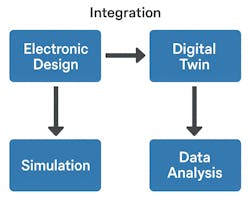Digital Twinning Adds Adaptability to Vehicle Electrification
With continued and growing supply chain uncertainties, vehicle electrification design and development processes more than ever need to be agile and adaptive, while also ensuring the best possible results. One option is to take a digital twin approach. It’s a technology that’s already being widely adopted. Instead of waiting months to build and test physical systems, EV manufacturers can use digital twins to accelerate iterations, refine electronics architectures, and optimize performance continuously.
For example, Tesla reportedly uses a form of digital twin technology to simulate both mechanical and electronic aspects of its vehicles for remote diagnostics, updates, and improving autopilot systems.
A digital twin is a virtual representation of a physical object, system, or process that’s continuously updated with real-time data to mirror its real-world counterpart. It combines data from sensors, machine learning, simulations, and other sources to model the behavior, performance, and condition of the physical entity. And while often discussed in terms of supporting technology or systems in service, e.g., anticipating needed repairs, it can also be integrated from the inception of a design or system.
Currently, digital twins are used in various fields like manufacturing, healthcare, construction, and smart cities for purposes such as predictive maintenance, performance optimization, monitoring and control, and design testing and validation. For example, a digital twin of a wind turbine might use sensor data to simulate wear and tear, predict failures, and suggest electrical efficiency improvements.
>>Download the PDF of this article
A digital twin can play a major role in the development and updating of electric-vehicle (EV) electronics by acting as a high-fidelity virtual replica of physical EV systems, particularly electronic control units (ECUs), battery-management systems (BMS), power electronics, and communication networks (see figure).
How Can a Digital Twin Help with Design and Development?
Using a digital twin, engineers can design and validate electronics (like motor controllers, battery management, chargers) virtually before building physical prototypes. A twin also allows for simulation of extreme conditions (temperature, load, voltage fluctuations) to test robustness and failure modes without damaging hardware.
Similarly, embedded software, whether developed specifically for an ECUs, BMS, inverter control, etc., and/or whether “commercial off the shelf” or custom designed, can be developed and tested directly against the digital twin. This supports continuous integration and validation without needing access to the physical EV or subsystem, reducing time and cost and supporting more robust testing and improvement processes.
Digital twins provide real-time feedback and data on system performance, allowing for iterative design improvements and optimization. Engineers can explore different design options, identify potential issues early on, and optimize for factors like power density, heat dissipation, and signal integrity.
Digital twins can also help optimize different aspects of the product throughout the design and manufacturing processes, not just circuitry or a particular subsystem. And they’re capable of integration with electronic design automation (EDA) tools.
What’s the Role of Digital Twins in System Integration?
A digital twin can significantly streamline and improve electronic system integration by providing a real-time, data-driven virtual model of the system that enables design, testing, and optimization before and during physical implementation. When multiple electronics (e.g., motor control, battery, infotainment) must work together, a digital twin helps detect integration issues early (e.g., communication delays, CAN bus errors).
Even with tricky issues like EMI, where a twin may have limited ability to model these complex interactions, it can be helpful in modeling the impact of changes that might be needed to solve an EMI challenge. Ultimately, it reduces the time required to reach a solution.
Integration can also be improved by “twinning” through early design validation that simulates the interaction between hardware and software components. In addition, it would identify potential compatibility issues before building physical prototypes.
A digital twin can provide system-level simulation that models the complete electronic system, including power distribution, signal integrity, thermal behavior, and communication protocols. Thus, it helps optimize layout, performance, and component choices.
How Can a Digital Twin Support Faster Testing and Debugging?
Virtual testing makes it possible to simulate edge cases and fault conditions that are hard to recreate physically. A digital twin also reduces the number of physical prototypes required, saving cost and time.
Digital twins can be tied into hardware-in-the-loop (HIL) and software-in-the-loop (SIL) testing environments, allowing partial real hardware to be tested against full virtual models. These factors can lead to faster iteration and innovation.
Digital twinning is able to improve collaboration by helping provide a single source of truth for cross-functional teams (hardware, software, mechanical, and systems engineers). This may also enable concurrent development and integration, speeding up the overall cycle or potentially spawning useful parallel development programs.
Finally, digital twins can be useful in every phase of lifecycle management, whether it’s assisting in managing firmware updates, part replacements, and retrofitting, or updating over time to reflect changes or upgrades in the actual electronic system.
References:
>>Download the PDF of this article
About the Author



